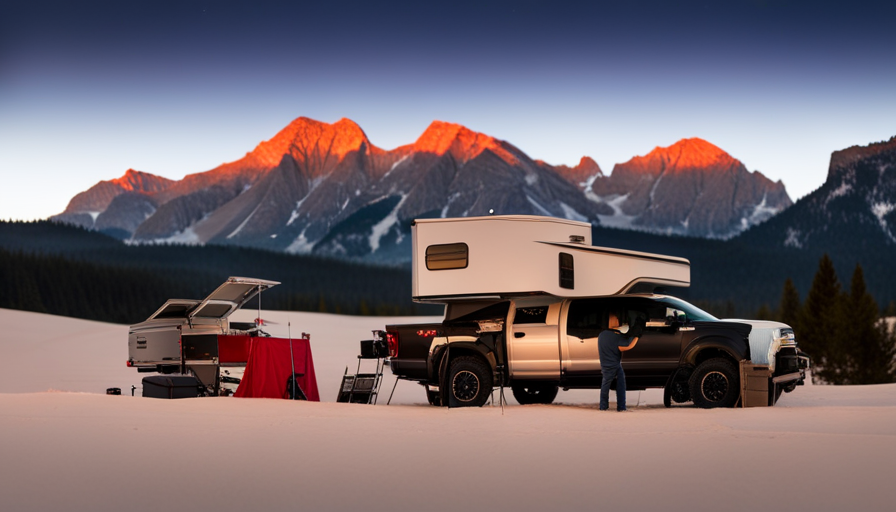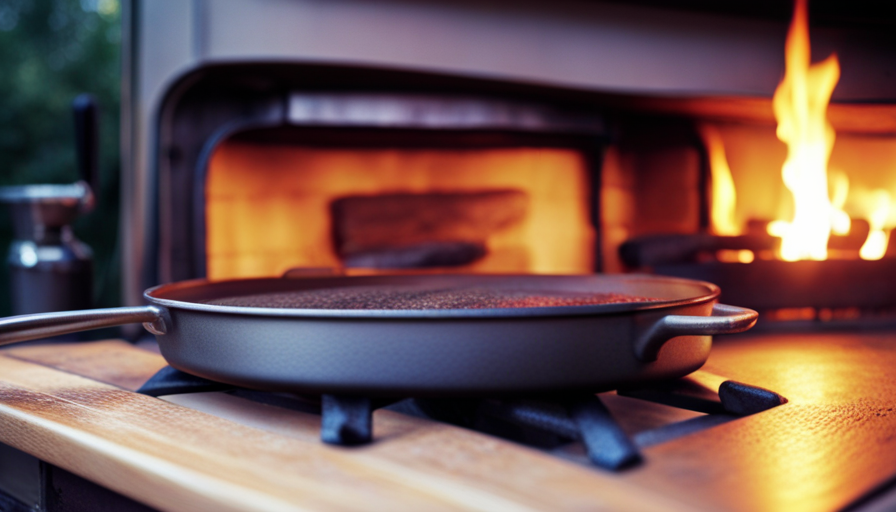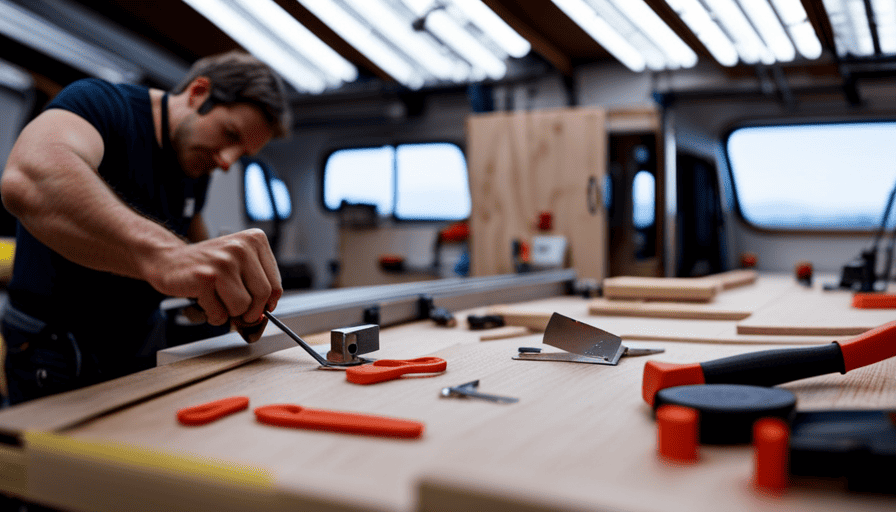Have you ever dreamed of going on a spontaneous road trip, with the freedom to explore wherever your heart desires?
Well, if you’re a truck owner, I have just the thing for you – a truck camper! These versatile and compact homes on wheels are the perfect option for those seeking an adventurous getaway.
But before you can embark on your journey, you need to know how to properly load your truck camper. In this article, I will guide you through the step-by-step process of loading a truck camper to ensure a safe and secure travel experience.
From proper weight distribution to securing the camper, we’ll cover it all. So, buckle up and get ready to learn how to load your truck camper like a pro!
Key Takeaways
- Proper weight distribution is crucial for a safe and smooth ride
- Secure the camper with turnbuckles or tie-down straps for stability
- Connect electrical and plumbing systems in the truck camper and test connections
- Thoroughly inspect everything before hitting the road, including the weight of the camper, tires, suspension system, and camper itself
Ensure Proper Weight Distribution
Make sure you’ve got the right balance, so you don’t have any wobbles or wiggles on your journey! Proper weight distribution is crucial when loading a truck camper. Not only does it ensure a safe and smooth ride, but it also prevents damage to your vehicle and camper.
To achieve proper weight distribution, there are a few important steps you should follow.
First, you need to know the weight ratings of your truck and camper. This information can usually be found in the owner’s manual or by contacting the manufacturer. It’s important to stay within these weight limits to avoid overloading your vehicle.
Next, distribute the weight evenly between the front and rear axles. Placing too much weight on one side can cause your vehicle to sway or become unstable. Use a scale to measure the weight of the camper on each side and adjust accordingly.
Additionally, always secure your cargo properly. Use tie-down straps or bungee cords to prevent any items from shifting during transit. This will help maintain proper weight distribution and ensure a safe journey.
Proper weight distribution is essential for a safe and stable truck camper load. By following these safety precautions, you can enjoy a smooth and worry-free journey.
Now that you’ve ensured the right balance, let’s move on to preparing your vehicle for the road ahead.
Prepare Your Vehicle
To get your vehicle ready for the journey, start by ensuring it’s equipped with all the necessary accessories.
First and foremost, check that your tires have the proper pressure. Proper tire pressure is crucial for safe and efficient travel. You can find the recommended pressure in your vehicle’s owner’s manual or on a sticker located on the inside of the driver’s side door. Underinflated tires can affect handling and fuel efficiency, while overinflated tires can increase the risk of a blowout.
Next, it’s important to check for vehicle compatibility. Make sure your truck is capable of safely carrying the weight of the camper. Consult your truck’s manual to determine its payload capacity, which is the maximum weight it can handle. Additionally, consider the weight distribution of the camper on your truck. Ensure that the weight is evenly distributed to prevent excessive strain on your vehicle’s suspension system.
With your vehicle properly prepared, the next step is to clear the bed of your truck. This will provide a clean and secure space for your camper to be loaded onto.
By following these steps, you’ll be well on your way to safely and efficiently loading your truck camper.
Clear the Bed of Your Truck
After ensuring your vehicle’s properly equipped and ready for the journey, it’s time to create a clean and secure space in the bed of your truck for the next step of preparing your camper.
Truck bed organization is crucial to ensure a smooth loading process and to maximize the available space. Here are three tips to help you organize your truck bed effectively:
-
Use storage bins: Utilize plastic storage bins to keep your gear organized and easily accessible. Label the bins according to their contents for quick identification.
-
Install a bed liner: A bed liner not only protects the bed of your truck from scratches and dents but also provides a non-slip surface for your camper. This prevents any shifting during transportation.
-
Consider loading ramp options: Loading ramps are essential for safely loading your camper onto the truck bed. There are various types of loading ramps available, such as folding ramps or telescoping ramps, which accommodate different camper weights and sizes.
With your truck bed organized and ready, you can now seamlessly transition into positioning the camper. This ensures a secure and stable foundation for your camper during the journey.
Position the Camper
Now that my truck bed is organized and ready, it’s time to securely position my camper for a smooth and stable journey. Proper positioning is crucial to ensure the weight is evenly distributed and the camper is properly aligned with the truck.
Here are some positioning tips and leveling techniques to consider.
First, I make sure the camper is centered on the truck bed. This helps distribute the weight evenly and prevents any imbalance during travel. I also ensure that the camper is positioned in a way that allows for easy access to the cab and tailgate.
Next, I use leveling blocks or ramps to adjust the height of the camper. This is important to ensure the camper is level and stable. I place the blocks or ramps under the wheels of the camper and gradually raise or lower them until the camper is level. This not only improves stability but also helps with proper weight distribution.
Additionally, I check the camper’s side-to-side alignment. I use a level or a simple leveling tool to make sure the camper is straight and not leaning to one side. This ensures a smoother and safer journey.
By following these positioning tips and leveling techniques, I can ensure that my camper is securely positioned for a comfortable and stable journey.
Now, let’s move on to the next step of securing the camper in place without compromising safety.
Secure the Camper
Once the camper is properly positioned, it’s essential to ensure its security during the journey. There are several anchoring methods that can be used to secure a truck camper and prevent it from shifting or falling off the truck bed.
One common method is to use turnbuckles or tie-down straps that are specifically designed for truck campers. These straps can be attached to the camper’s frame and then secured to the truck bed using anchor points. It’s important to tighten these straps properly to ensure a secure fit.
Another anchoring method is to use camper jacks or stabilizer bars. These can be placed at the corners of the camper and adjusted to provide stability and prevent any movement.
When securing a truck camper, it’s important to avoid some common mistakes. One mistake is not using the proper anchoring equipment or incorrectly installing it. This can lead to the camper becoming loose or unstable during transit. Another mistake is not regularly checking the tightness of the straps or jacks during the journey. The vibrations and movements of the road can cause them to loosen over time. It’s also important to avoid over-tightening the straps or jacks, as this can put unnecessary stress on the camper’s frame.
With the camper securely anchored, the next step is to connect the utilities for a comfortable journey.
Connect Utilities
When connecting the utilities in my truck camper, I first make sure to properly connect the electrical and plumbing systems. This involves hooking up the power cord and water hose to the appropriate outlets, and ensuring a secure connection.
After everything is connected, I test the connections to make sure they’re functioning properly. This includes checking that the electricity is working and water is flowing smoothly.
Lastly, I make sure to secure any loose wires or hoses to prevent any accidents or damage while on the road.
Connect electrical and plumbing systems
First, you’ll want to connect the electrical and plumbing systems in your truck camper to ensure a comfortable and functional experience on the road.
When it comes to troubleshooting common issues, it’s important to have a set of recommended tools and equipment on hand. For the electrical system, you’ll need wire connectors, electrical tape, a multimeter, and a power source.
Start by connecting the camper’s electrical panel to a power source, then run wires to various appliances and outlets. Remember to securely fasten the connections using wire connectors and electrical tape.
As for the plumbing system, you’ll need water hoses, pipe sealant, and adjustable wrenches. Connect the water hoses to the camper’s water inlet and outlets, ensuring a secure and leak-free connection.
Lastly, test the connections for proper functionality to ensure everything is working as it should before hitting the road.
Test the connections for proper functionality
To ensure a smooth and worry-free journey, it’s time to put your electrical and plumbing connections to the test and make sure everything is working perfectly.
Start by testing the electrical system. Plug in your truck camper to a power source and check if all the outlets are functioning. Use a voltage tester to ensure that each outlet is receiving the correct amount of power.
Next, test the plumbing system. Turn on the water pump and check for any leaks or unusual sounds. Run water through all the faucets and flush the toilet to make sure everything is flowing properly.
If you encounter any issues during testing, refer to the troubleshooting tips in your truck camper’s manual.
Once you’ve completed the testing procedures, you can move on to securing any loose wires or hoses to ensure they don’t cause any problems during your journey.
Secure any loose wires or hoses
After testing the connections for proper functionality, it’s important to secure any loose wires or hoses before loading the truck camper. This step ensures that everything is in its proper place and reduces the risk of any damage or accidents during transportation.
Loose wires can pose a safety hazard as they can get tangled or caught on objects, potentially causing a short circuit or electrical malfunction. Similarly, loose hoses can become entangled or damaged, leading to leaks or loss of functionality.
To manage loose wires, I recommend neatly bundling them together using zip ties or cable organizers. For hose organization, consider using hose clamps or mounting brackets to keep them secure and prevent any kinks or tangles.
By properly managing loose wires and hoses, you can ensure a safe and organized loading process.
Now let’s move on to the next step: checking for clearance.
Check for Clearance
When loading a truck camper, it’s important to check for clearance to ensure a safe and hassle-free journey.
First and foremost, I always make sure that the camper doesn’t obstruct my view while driving. This is crucial for maintaining visibility on the road and avoiding any potential accidents.
Secondly, I verify that the camper doesn’t exceed height restrictions set by local regulations. This helps me avoid any legal issues and ensures that I can safely pass under bridges or other structures without causing damage.
Lastly, I always make sure that the camper doesn’t interfere with my turn signals or brake lights. This ensures that I can effectively communicate my intentions to other drivers on the road, promoting a safer driving experience for everyone.
Ensure the camper does not obstruct your view
Make sure the camper doesn’t block your view, as 25% of accidents involving truck campers are caused by limited visibility.
To avoid blind spots, ensure proper mirror placement. Adjust your side mirrors so that you have a clear line of sight behind the camper. Make sure you can see the entire length of the camper and the road behind it. Additionally, consider installing extended side mirrors to improve visibility.
Another important aspect is to ensure that the camper does not obstruct your rearview mirror. Adjust it accordingly to have a clear view of the road behind you.
By taking these steps, you can greatly reduce the risk of accidents caused by limited visibility.
Now, let’s move on to the next section and verify that the camper does not exceed height restrictions.
Verify that the camper does not exceed height restrictions
It’s crucial to check if the camper fits within the height restrictions to ensure a safe and worry-free journey. Before loading the camper onto the truck, I use a tape measure to accurately measure its height. I measure from the highest point of the camper to the ground.
Once I have the height measurement, I compare it to the height restrictions set by the authorities. It’s essential to comply with these restrictions to avoid any accidents or fines. If the camper exceeds the height restrictions, I may need to make adjustments or find an alternative route.
By ensuring that the camper meets the height requirements, I can prevent any potential issues on the road.
Now, let’s move on to the next section and make sure the camper does not interfere with turn signals or brake lights.
Make sure the camper does not interfere with turn signals or brake lights
Hey, you wouldn’t want your precious little home-on-wheels blinding drivers with a disco light show, now would you?
When loading a truck camper, it’s crucial to ensure that it doesn’t interfere with turn signals or brake lights. This not only prevents accidents but also ensures everyone’s safety on the road. Here are three safety precautions to consider:
-
Positioning: Place the camper in a way that doesn’t obstruct the visibility of your vehicle’s turn signals and brake lights.
-
Wiring: Double-check the camper’s wiring to ensure it’s properly connected and doesn’t cause any interference with the vehicle’s electrical system.
-
Height adjustment: If necessary, adjust the camper’s height to avoid any obstruction of the turn signals or brake lights.
By taking these interference prevention measures, you can ensure a safe and hassle-free journey.
Now, let’s move on to performing a test drive to ensure everything’s in perfect order.
Perform a Test Drive
Start by taking the truck camper for a test drive to assess its stability and handling on the road, ensuring a safe and enjoyable journey. Before embarking on the drive, it is crucial to perform a safety check to ensure that everything is in working order. Inspect the tires, brakes, and suspension to guarantee that they are in optimal condition. Once the safety check is complete, it is time to hit the road.
During the test drive, pay close attention to the camper’s stability and handling. Evaluate how the camper responds to turns, accelerations, and sudden stops. Take note of any unusual noises or vibrations that may indicate a problem. It is essential to ensure that the camper does not interfere with the truck’s ability to turn or brake properly.
To help you visualize the camper’s performance, here is a table that highlights the key aspects to consider during the test drive:
| Aspect | Evaluation |
|---|---|
| Stability | Assess how the camper handles on straight roads and curves |
| Handling | Evaluate the camper’s response to turns and sudden maneuvers |
| Noise/Vibrations | Pay attention to any unusual sounds or vibrations |
| Braking | Observe the camper’s ability to stop smoothly and quickly |
| Interference | Ensure the camper does not hinder the truck’s turn or brake signals |
After the test drive, make adjustments as needed to ensure that the camper is securely attached to the truck and does not interfere with its functionality.
Make Adjustments as Needed
After performing a test drive with the truck camper, it’s important to make necessary adjustments and adapt as needed to ensure a safe and secure loading process.
Each truck and camper combination is unique, so it’s crucial to take the time to make any necessary modifications to the camper or truck bed to ensure a proper fit. This may include adjusting the camper’s tie-downs, repositioning the camper to distribute weight evenly, or making modifications to the truck bed if needed.
One common adjustment that may need to be made is to the camper’s tie-down system. This system is responsible for securing the camper to the truck bed, and it’s essential that it’s properly adjusted to prevent any movement or shifting during travel.
Additionally, it’s important to check the suspension and tire pressure of both the truck and the camper to ensure they’re in optimal condition for the load.
As I prepare to double-check everything, I’ll ensure that all adjustments have been made and that the truck camper is securely fastened to the truck bed. This will provide peace of mind knowing that the camper is properly loaded and ready for the next adventure.
Double-Check Everything
Before hitting the road, it’s crucial to thoroughly inspect every detail to ensure a smooth and worry-free journey ahead. When it comes to loading a truck camper, there are certain steps that should not be overlooked.
One important aspect is to double-check the weight of the camper and make sure it falls within the recommended limits for your specific truck. Overloading can lead to safety hazards and unnecessary strain on your vehicle.
Start by inspecting the truck itself. Check the tires to ensure they’re properly inflated and in good condition. Look for any signs of wear or damage that may affect the stability of the truck while carrying the camper. It’s also important to check the suspension system to ensure it can handle the additional weight.
Next, thoroughly inspect the camper. Make sure all doors and windows are securely closed and latched. Check for any loose or damaged parts that may need to be repaired or replaced. Pay special attention to the hitching system and make sure it’s securely attached to the truck.
By taking the time to double-check these important details, you can have peace of mind knowing that your truck camper is loaded properly and ready for the journey ahead.
Frequently Asked Questions
What are the necessary utilities that need to be connected when loading a truck camper?
When loading a truck camper, it’s important to connect the necessary utilities to ensure proper functionality. These utilities typically include electrical connections for powering lights and appliances, as well as water and sewage connections for plumbing needs.
Additionally, weight distribution is crucial to maintain stability and safe driving. This involves properly distributing the camper’s weight over the truck’s axles, using methods such as using a weight distribution hitch or adjusting the camper’s positioning on the truck bed.
How can I ensure that the weight distribution of the camper is appropriate for my vehicle?
To ensure appropriate weight distribution of the camper on my vehicle, I take several steps.
First, I consult my vehicle’s manual to determine the maximum weight capacity.
Then, I distribute the weight evenly across the camper, placing heavier items closer to the center of the vehicle.
I also use a weight distribution hitch, which helps evenly distribute the camper’s weight on the vehicle’s axles.
This ensures optimal vehicle compatibility and prevents any potential safety issues on the road.
Are there any specific safety precautions I should take while securing the camper?
When it comes to securing a truck camper, safety measures are of utmost importance. Proper anchoring is essential to ensure the camper stays in place while driving. It’s crucial to use high-quality straps and tie-downs to secure the camper firmly to the truck bed. Make sure to follow the manufacturer’s instructions for proper anchoring points and techniques. Regularly check the straps for any signs of wear or looseness during your journey to ensure a safe and secure load.
What should I do if I encounter clearance issues when positioning the camper?
If I encounter clearance issues while positioning the camper, I know it can be frustrating.
To tackle this problem, I ensure that I carefully assess the height and width of the space I want to park in. If the clearance is too low, I look for an alternate spot or adjust the camper’s height if possible.
It’s crucial to take my time and be cautious to avoid any damage to the camper or surrounding objects.
Is there a recommended checklist or guide to follow when double-checking everything before hitting the road?
Before hitting the road with a truck camper, it’s important to double-check everything to ensure a safe journey. To do this, it’s recommended to have a checklist in place. This checklist should include:
- Verifying that all doors and windows are securely closed
- Checking the tire pressure and tread
- Inspecting the hitch and connections
- Testing the brake lights and turn signals
- Confirming that all equipment and supplies are properly stowed
By following a recommended checklist and double-checking everything, you can have peace of mind knowing that you’re ready for the road.
Is the Process of Lifting a Pop Up Camper Similar to Loading a Truck Camper?
The process of lifting a pop up camper differs from loading a truck camper. Lifting a pop-up camper involves raising the roof and extending the collapsible walls. It requires unlocking and cranking mechanisms, making it easier to set up. Loading a truck camper, on the other hand, typically involves securing it onto the truck bed. Both have their unique steps, making them distinct processes.
Conclusion
In conclusion, loading a truck camper is a process that requires careful planning and attention to detail. By ensuring proper weight distribution, preparing your vehicle, and securing the camper correctly, you can have a safe and successful trip. It’s important to double-check everything before hitting the road to avoid any potential issues.
I once heard someone say that loading a truck camper is like building a strong foundation for a house. Just as a well-built foundation supports the entire structure, properly loading a camper ensures stability and balance during your journey. So take the time to follow these steps and enjoy your adventures on the road with peace of mind.










